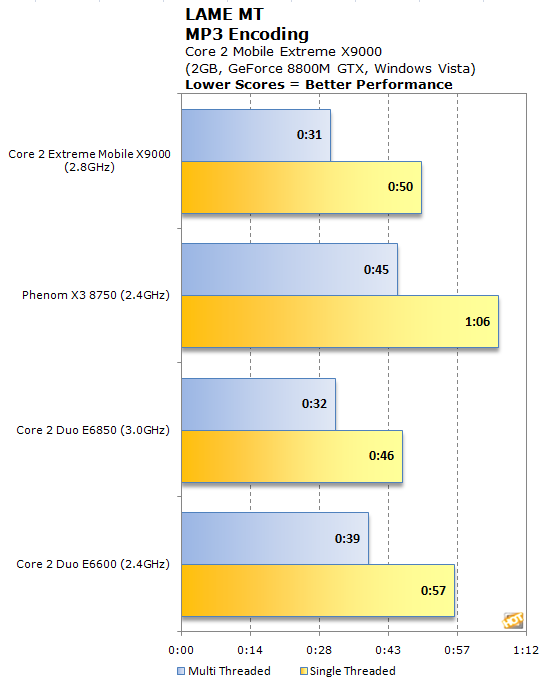Intel Core 2 Extreme Mobile X9000, Mobile Penryn Speed
Lame Multithreaded and Kribibench
Next we journeyed on to what are generally considered more traditional CPU intensive tests with a multithreaded version of LAME MP3 encoding and our usual run of Kribibench software 3D rendering.
|
|
|
In this test, we created our own 223MB WAV file (a hallucinogenically-induced Grateful Dead jam) and converted it to the MP3 format using the multi-thread capable LAME MT application in single and multi-thread modes. Processing times are recorded below, listed in seconds. Once again, shorter times equate to better performance.

The 2.8GHz dual-core Core 2 Extreme Mobile X9000 shows itself to be significantly faster than a 2.4GHz tri-core Phenom in MP3 encoding with LAME. We should note however that at this point in time this test only supports up to two threads concurrently. Also, what's perhaps a bit more interesting is the fact that our 2.8GHz mobile CPU actually keeps tight pace with the 3GHz Core 2 Duo E6850, once again flexing its 6MB cache muscle versus the 4MB of L2 resources available on the desktop Conroe core-based chip.
|
|
|
For this next batch of tests, we ran Kribibench v1.1, a 3D rendering benchmark produced by the folks at Adept Development. Kribibench is an SSE aware software renderer where a 3D model is rendered and animated by the host CPU and the average frame rate is reported. We used two of the included models with this benchmark: a "Sponge Explode" model consisting of over 19.2 million polygons and the test suite's "Ultra" model that is comprised of over 16 billion polys.

Since Kribibench is multithreaded and heavily SSE optimized, the numbers fall in line more with respect to core clock speed and available multi-core resources. The tri-core Phenom is the fastest of the group, followed by the 3GHz Core 2 Duo and the rest of Intel's offering, including the X9000, respectively.






